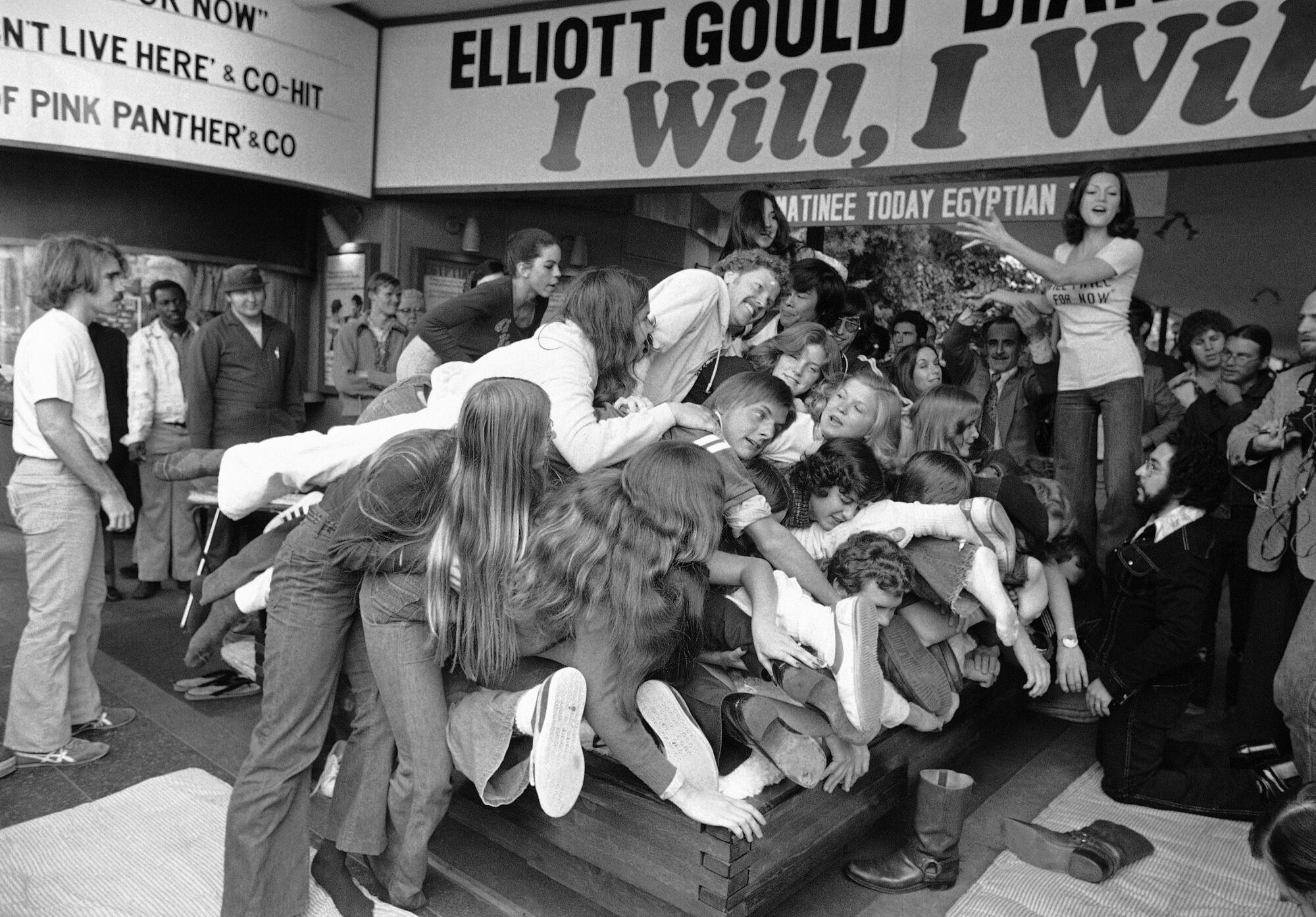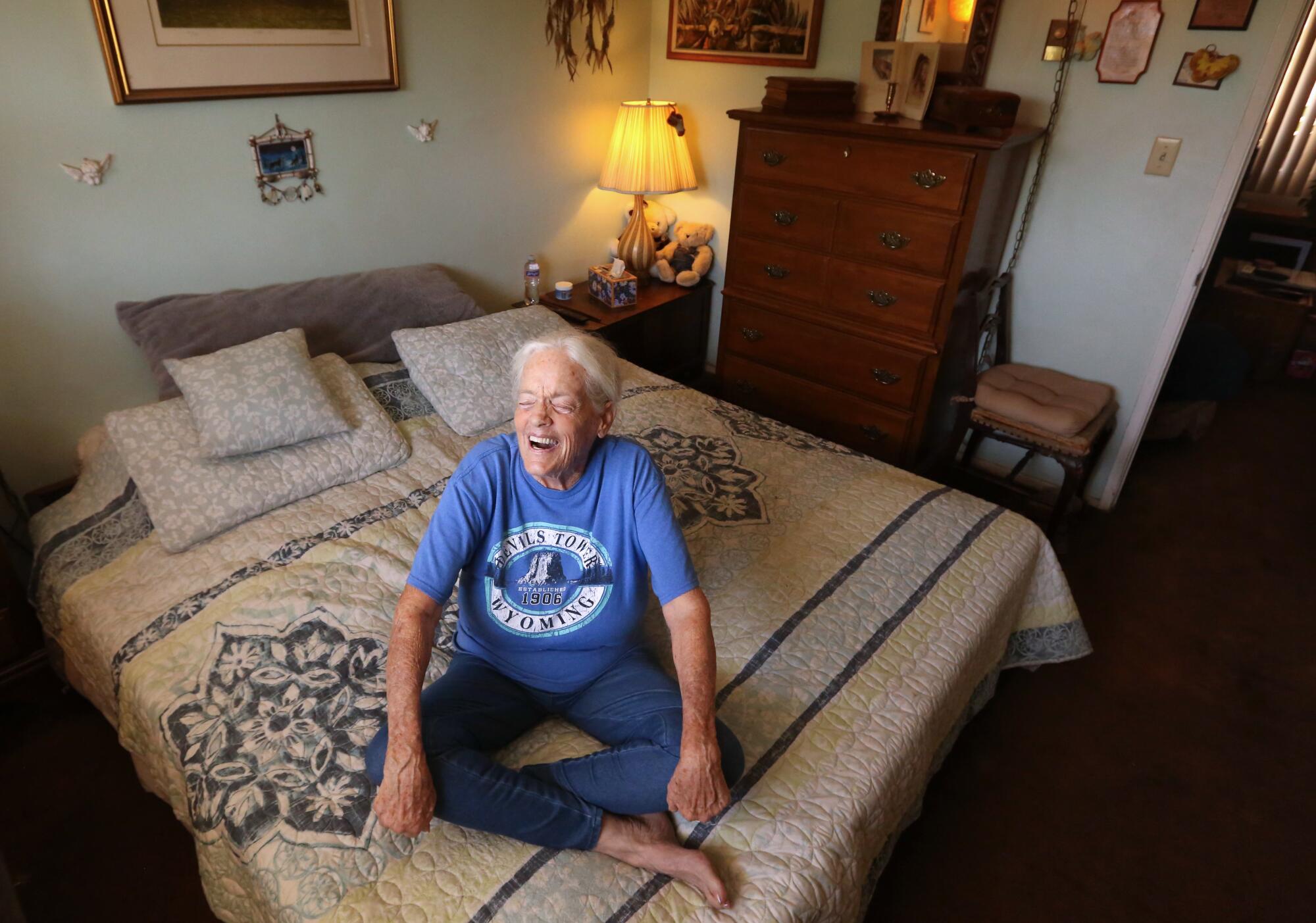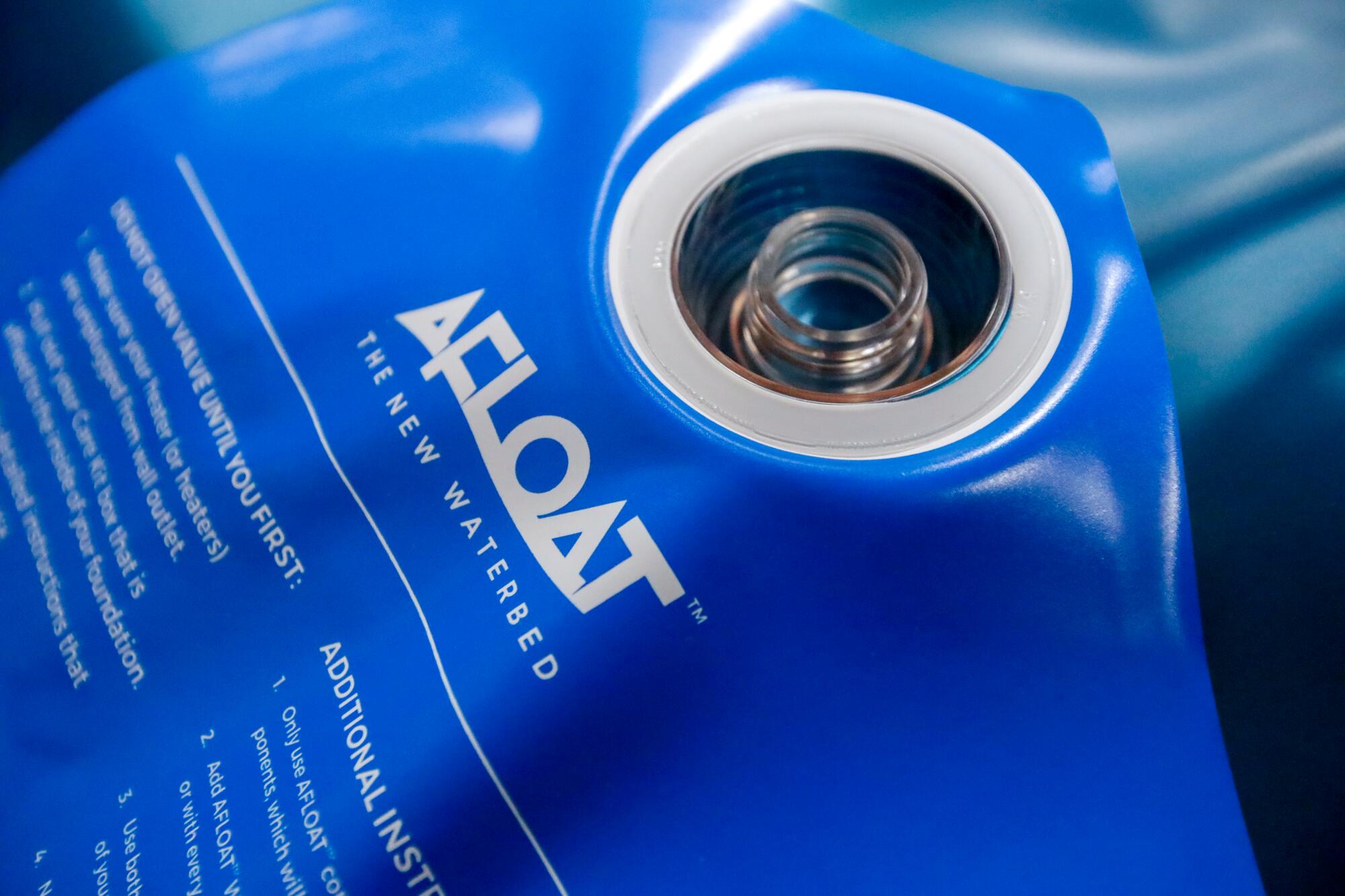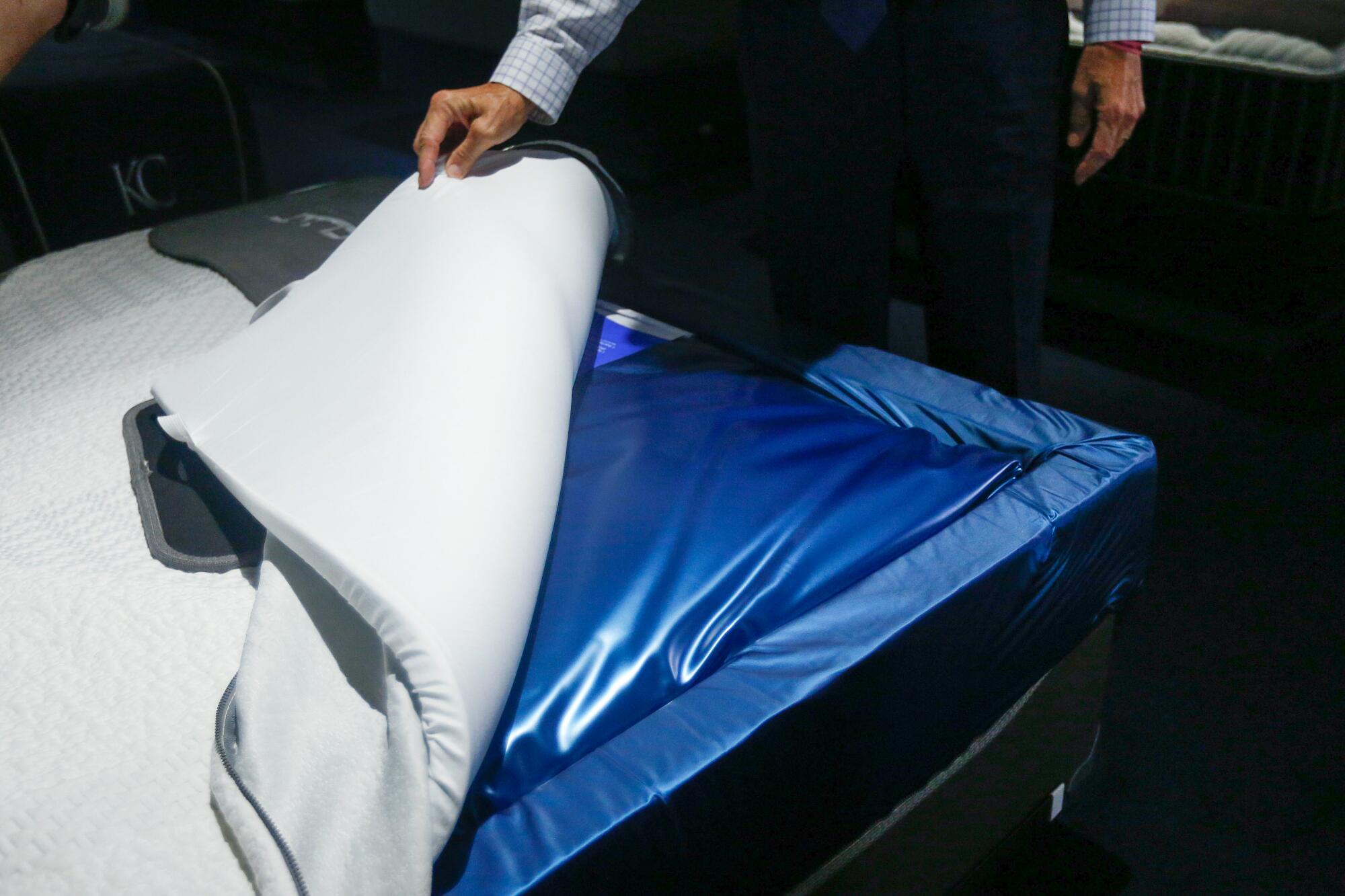The mattress in Nancy Gerrish’s brilliant Los Feliz house seems completely regular — carved wood headboard, fuzzy brown blanket, cream-colored mattress skirt. The sheets are a tasteful leopard print. A couple of brocade throw pillows lie atop the unfold to finish the earth-tone look.
However beneath that plush exterior, Gerrish’s mattress hides a jiggling secret.
Sit on the mattress’ edge and it wobbles and undulates. Lie down and it rocks gently, as in case you’re floating above a temperate pool of water.
And certainly, you’re.

In L.A., water guidelines all the pieces round us. Drink up, cool off and dive into our tales about hydrating and recreating within the metropolis.
“I inform folks I’ve a waterbed, and everybody laughs,” says Gerrish, 78, a monetary planner with white curly hair and manicured lavender nails. “But it surely’s a really comfy mattress to sleep in, and I personally don’t know why the world doesn’t have this.”
For those who thought waterbeds had gone the way in which of Seventies traits like Troll dolls and polyester pantsuits, you’re principally appropriate. The wavy vinyl mattresses that turned an emblem of the period’s intercourse, medication and rock ’n’ roll way of life might now not be a part of the collective consciousness besides because the butt of a joke in a interval movie or as a forbidden merchandise on a boilerplate residence lease. However they will nonetheless be discovered gently rippling in a handful of Southern California bedrooms.
Waterbeds account for lower than 2% of all mattress gross sales right now, in keeping with the Specialty Sleep Assn., however the few remaining retailers obtain each day calls from cussed holdouts like Gerrish — principally older of us who purchased a fluid-filled mattress many years in the past, fell in love with its wavy movement and received’t sleep on anything. Now, these waterbed fanatics scour the web for alternative mattresses, heaters and water therapy methods, decided to withstand sleeping on normal mattresses — what they name “lifeless beds” — for so long as they will.
“I fear,” mentioned Donna Martin, 77, of Glendale, who has been sleeping in a waterbed for 50 years. “I believe to myself if I ever have to enter a house, they received’t give me no waterbed.”

Forty-seven college students from UCLA pile on high of a water mattress , March 10, 1976, to determine a brand new report for a human pyramid on a water mattress in Los Angeles. They broke the previous report of 16, in keeping with the press agent, in a stunt to publicize a then-current Hollywood manufacturing.
(Wally Fong / Related Press)
The ‘Pleasure Pit’ increase
The trendy waterbed was invented in 1968 by Charles Corridor, a graduate scholar at San Francisco State, as a part of his grasp’s thesis in design. Corridor, then 24, had initially got down to create the world’s most comfy chair, filling a plastic sack with gelatin after which cornstarch with disappointing outcomes. Ultimately, he landed on a profitable system — an 8-foot water-filled sq. vinyl mattress. He referred to as it the “Pleasure Pit” and imagined it as a bed-chair hybrid — the one piece of furnishings one would want.
“It was new, it was thrilling, it was completely different, it was attractive, it was enjoyable. It was our technology’s mattress.”
— Denny Boyd, former president of the Waterbed Producers Affiliation.
His prototype was featured in a present referred to as “Completely satisfied Happenings” on the San Francisco Cannery artwork gallery that summer time and articles a couple of new-fangled waterbed quickly had been showing in newspapers and magazines throughout the nation. A contemporary sleep development was born.
“It was new, it was thrilling, it was completely different, it was attractive, it was enjoyable,” mentioned Denny Boyd, former president of the Waterbed Producers Assn., who as soon as owned 35 waterbed shops all through Texas, Missouri and Louisiana. “It was our technology’s mattress.”
Waterbed gross sales skyrocketed from an estimated $13 million in 1971 to $1.9 billion in 1986, in keeping with the New York Occasions. The mattresses had been pretty low cost, however gross sales of the heavy wooden frames that saved the mattresses from flopping round, plus water heaters and conditioners, introduced in large bucks. By 1991, roughly 1 in each 5 mattresses offered in America was fluid-filled, in keeping with the Washington Put up. Corridor obtained a patent for his invention in 1971 however not often enforced it, and younger entrepreneurs rapidly turned the waterbed enterprise right into a profitable trade.
“There have been a complete lot of people that had been millionaires by the point they had been 25,” Boyd mentioned.
It was a wild, sex-soaked enterprise. One early advert declared, “Two issues are higher on a waterbed. Considered one of them is sleeping.” Boyd remembers internet hosting pajama occasion gross sales occasions at his shops the place clients would present up in outrageous sleepwear — see-through nighties and G-strings. The shop served wine and cheese and stayed open till 3 or 4 a.m.
“It was greater than R-rated,” Boyd mentioned.
Competitors among the many principally male gross sales power was fierce. “Folks used to throw rocks at one another’s shops and look in dustbins to see consumer lists,” Boyd mentioned. “On the commerce exhibits, you needed to rent a safety guard to observe your house so folks wouldn’t sneak again in and poke holes in your mattress.”
By the mid-Nineteen Nineties, nonetheless, the occasion was over. After a precipitous rise, the waterbed market dried up. Boyd says the decline was as a consequence of a handful of things, one in all which was the arrival of the “softside” waterbed mattress, which appeared and felt extra like a conventional mattress and didn’t require pricy mattress frames or particular sheets — equipment that generated the majority of the income for waterbed shops. On the similar time, a number of new different mattress applied sciences hit the market, together with airbeds, the Sleep Quantity, Tempur-Pedic and reminiscence foam.
“These had been extra typical beds, simpler to promote and simpler,” Boyd mentioned. “Additionally they had a lot of promoting behind them.”
In 1995, the Waterbed Producers Assn. rebranded itself because the Specialty Sleep Assn.

Donna Martin, 77, rests on her waterbed in her residence in Glendale. Martin has used waterbeds for the previous 50 years.
(Genaro Molina / Los Angeles Occasions)
Devoted ‘water heads’ stay
For some, the waterbed was by no means a passing development. It‘s a lifelong devotion.
Gerrish, the monetary planner from Los Feliz, purchased her first water-filled mattress in 1996 after sleeping on a pal’s waterbed. “I couldn’t consider how comfy it was,” she mentioned. “It’s very gentle on all of your joints, and in case you prefer to cuddle, your arm sinks into the mattress so there’s no strain on it.”
She moved her waterbed to Los Angeles from New York 21 years in the past. When she finally sells her Los Feliz house, she hopes to take it along with her wherever she strikes subsequent. (She was relieved to be taught that it’s unlawful for landlords to forbid waterbeds in California in rental models constructed after 1973, although they will require tenants to have insurance coverage for injury attributable to the mattress.)
“I really feel so cozy. It’s arduous to get out of it,” she mentioned. “And anybody visiting me loves it. I believe the [traditional] mattress corporations don’t need this data getting out.”
Gerrish has been sleeping on a water-filled mattress for 28 years, however a number of L.A. waterbed lovers have had a fair longer relationship with Corridor’s 1968 invention.
Martin, the 77-year-old in Glendale, has been sleeping on a waterbed since she received her first one as a hand-me-down from a pal.
“I’ve had 5 mattresses because the first time I set one up. I adore it,” she mentioned.
Not too long ago, she slept on her sister’s Swedish reminiscence foam mattress whereas taking good care of her pets for the weekend. The decision? No, thanks. Martin has a squashed disk in her backbone and finds the waterbed is simpler on her hips.
“At first it was OK, however then the identical factor occurred, an excessive amount of strain,” she mentioned. “I’d slightly stay awake in one thing else.”

A closeup of a waterbed on the Afloat manufacturing unit in Corona.
(Chris Carlson / Related Press)

Metropolis Furnishings CEO Keith Koenig exhibits the brand new waterbed on show as he speaks throughout an interview with the Related Press in Tamarac, Fla., in 2018. Koenig and inventor Charles Corridor, pioneers of the waterbed trade in the US, are hoping to generate a brand new wave of recognition for the previous furnishings idea by utilizing a healthful new pitch.
(Brynn Anderson / Related Press)
Steve Hertzmann, 62, of San Pedro, will get it. He’s been a waterbed devotee for 40 years and is shocked that the wavy mattresses have by no means made a comeback.
“The perfect half is within the wintertime once you’re freezing chilly,” he mentioned. “The waterbed has a heater, and also you hop in and also you’re all heat.”
Marty Pojar, who has a retailer referred to as the Waterbed Physician in Westminster, would like to see a renaissance, however he thinks the expertise wants a rebrand.
“The phrase ‘waterbed’ creates a stigma,” he mentioned. “When folks hear it, they’re considering of the massive, previous wood-frame waterbeds with a lot of wave motion.”
Actually, waterbeds have advanced through the years. Shoppers can now choose amongst mattresses that supply old-school full-motion waves and others which can be semi-waveless or have virtually no waves in any respect. Many beds even have two separate water mattresses, one on both sides, so if two persons are sleeping collectively and one individual will get away from bed, the opposite doesn’t expertise any rocking.
With sufficient promoting {dollars} behind it, Pojar thinks renaming waterbeds “flotation sleep methods with temperature management” may herald new clients.
“Reeducating the general public is a giant problem, however there’s a large alternative there, I consider,” Pojar mentioned.
For now, longtime devotees are protecting his enterprise alive. Change might be tough for a lifelong waterbed fan, as Larry Johnson of Mar Vista has realized firsthand.
The accountant slept on a waterbed for 50 years, till Could, when his spouse satisfied him that a regular mattress would make it simpler to get away from bed as they age.
A couple of days in, Johnson was on the fence. The “lifeless mattress” was not as gentle as his waterbed. He missed the rocking movement.
“It’s going to take some getting used to,” he mentioned.





